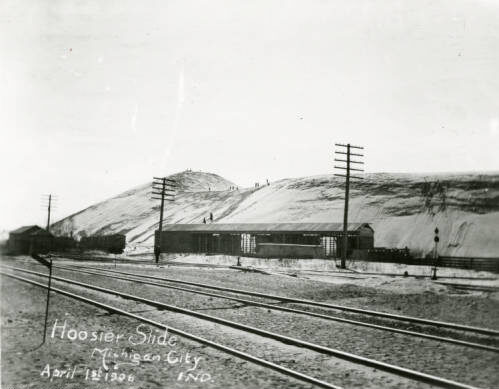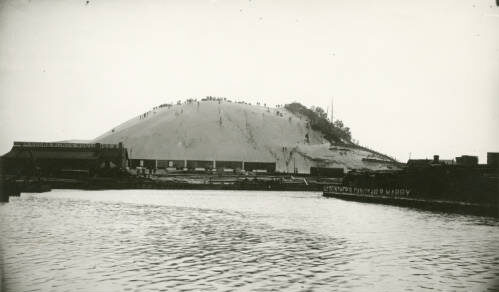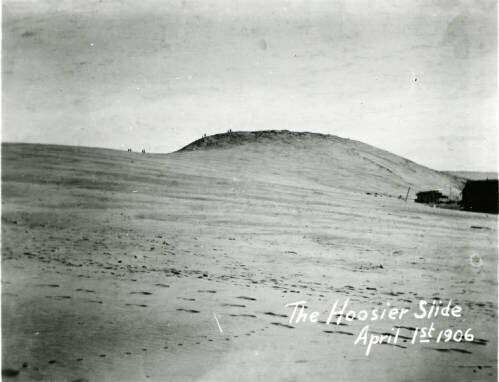
Purchase Tickets
The Hoosier Slide
June 16, 2025

At eleven o’clock on a Wednesday morning in 1930 government dignitaries and civic leaders gathered to lay the cornerstone for a structure that represented, according to an editorial writer for the Michigan City News, “a new industrial era” for the city—a $9 million generating plant for the Northern Indiana Public Service Company. The writer envisioned the “location of many splendid industries in Michigan City,” attracted by the availability of cheap power, a good transportation system, and the city’s central location in the United States.
Buried in the News description of the event was the information that the station occupied a tract of land formerly home to one of the area’s notable landmarks, the giant sand dune known as the Hoosier Slide. Today, nothing is left of the mountain of sand that could be seen as far away as Chicago and managed, year after year, to attract countless tourists to its slopes.

The Hoosier Slide was Indiana’s largest sand dune until it was leveled in 1920 due to sand mining by companies like Ball Brothers Company in Muncie, IN. The sand from the dune was important for the signature blue color associated with Ball Brothers jars. This photograph shows people standing on top of the dune.
The spectacular view of Lake Michigan offered by dunes such as the Hoosier Slide provided a powerful enticement to early travelers. In 1836 Englishwoman Harriet Martineau, a writer traveling from Detroit to Chicago, stopped in Michigan City to see Lake Michigan. Although she had to endure wet weather and bad roads on her journey, when she finally made it into Michigan City what she saw impressed her, especially her splendid view of the lake. Upon arriving in the city, Martineau and a traveling companion “were anxious to see the might fresh water sea.” The two ran up a dune covered with pea vine and beheld what they had traveled so far to see. Martineau noted: “The whole scene stands insulated in my memory, as absolutely singular; and, at this distance of time, scarcely credible. I was so well aware on the spot that it would be so, that I made careful and copious notes of what I saw; but memoranda have nothing to do with such emotions as were caused by the sight of that enormous body of tumultuous waters, rolling in apparently upon the helpless forest,—everywhere else so majestic.”
William Woodward, who had come to Michigan City in the 1840s to work in a general store, painted a less flattering picture of the town. Writing back to his brother in Middletown, Connecticut, Woodward complained that “M. City is the homliest [sic] place in the world, I suppose, or at least I never saw a worse looking one.” He went on to say that the community was “built on the sand where nothing will grow and I have not seen such a thing as a garden here.”

The Hoosier Slide was Indiana’s largest sand dune until it was leveled in 1920 due to sand mining for companies like Ball Brothers Company.
Although all Woodward could see was sand, other more enterprising merchants saw the gritty substance as something else—a gold mine. By the 1890s the Hoosier Slide, along with the Indiana State Prison, attracted tourists from Chicago, Lafayette, Peru, Indianapolis, and other towns. The Monon, Lake Erie & Western, and Michigan Central railroad lines lured passengers to Michigan City by touting the Hoosier Slide’s beauty and its panoramic view of Lake Michigan. Even those just passing through on trains were awed by the Hoosier Slide’s size. Writing about the sand hill, Carter H. Manny, whose father William B. Manny would be one of the first to see the potential industrial uses for Hoosier Slide, noted that “some people from afar who passed through in the winter time often inquired of the railroad men how such a big pile of snow got there.”
Several excursion steamers also made Michigan City a main destination. Ships such as the Theodore Roosevelt, United States, Indianapolis, Soo City, City of Grand Rapids, and Christopher Columbus brought countless visitors to Michigan City’s shores. The Michigan City News announced on 17 August 1887 that six hundred tourists, after working up an appetite while seeing the sights, had dined at Shultz’s restaurant. Gladys Bull Nicewarner, in her history of the city, reported that on one day (25 July 1914) six steamers brought approximately ten thousand people to see the northwest Indiana community’s attractions.
To entice more and more tourists to their fair city, Michigan City merchants offered merchandise and cash prizes for races up the giant sand pile’s slopes and even held marriage ceremonies on its peak. An Indiana State Prison official, hoping to attract visitors from southern Indiana, offered a free marriage license, minister, and excursion to any couple who would be willing to exchange their wedding vows on Hoosier Slide. A Mr. Plasterer, a southern Indiana farmer, and his bride-to-be accepted the offer, and many local residents and excursionists trooped up the sandy slopes to witness the happy occasion.
A local newspaper reported that after the ceremony was completed, the minister offered a poem to the newlyweds. He intoned:
To you, who now stand side by side,
On this, the top of Hoosier Slide,
I have pronounced you man and wife,
As long as you both shall live this life,
Now, Mr. and Mrs. Plasterer,
Shun the ways which lead to disaster,
And choose the path, which Christ has given,
The path which leads from earth to heaven.
In addition to marriages, the towering sand dune hosted hill-climbing contests, firework displays, and wrestling and boxing matches. “There always seemed to be human beings here and there on its slopes and top during all seasons of the year,” said Carter Manny. Daredevil youngsters used wooden toboggans and hand-fashioned metal sheets to slide down the hill during winter and summer. The ship captains who brought tourists and freight to Michigan City also depended on the landmark.

The Hoosier Slide was Indiana’s largest sand dune until it was leveled in 1920 due to sand mining for companies like Ball Brothers Company.
The beginning of the end for Hoosier Slide came in the late 1890s. From time to time, the Monon Railroad, which ran a switch track alongside Hoosier Slide’s eastern slope, received requests from a downstate Monon agent for Michigan City sand. It was used to sand railroad tracks for better traction. This development caught the attention of William Manny, who worked for the line for a number of years and grew up in Michigan City. Manny and I. I. Spiro, a local lawyer, began purchasing large amounts of lakefront land, believing that the region was ripe for industrial development. Hoosier Slide was part of this property, and in 1906 Manny incorporated the Hoosier Slide Sand Company. The giant sand dune’s death warrant had been signed.
Hoosier Slide’s destruction was aided by the industrial boom that occurred after the discovery of extensive supplies of natural gas in central Indiana in the mid-1880s. Cities such as Muncie, Anderson, Kokomo, Richmond, and others were soon besieged with new factories wanting to take advantage of this cheap natural resource. Glass companies, for example Ball Brothers in Muncie and the Pittsburgh Plate Glass Company in Kokomo, sent north for Michigan City sand to help manufacture their products.
Glass factories were not the only concerns clamoring for sand, according to Carter Manny, who, upon his return from college in 1912, took over the sand business from his father. Manny, who faced competition from another firm, the Pinkston Sand Company, which was served by the Michigan Central Railroad, filled orders not only from Indiana businesses, but also from companies as far away as Massachusetts and Mexico. Hoosier Slide sand was used for making glass insulators for telegraph and telephone poles, cores in iron foundries, and sand beaches for lakes and municipal bathing areas; it was even used as a fill for sand traps at Hoosier humorist George Ade’s private golf course in Kentland, Indiana.
In the beginning, workers known as dockwallopers loaded the sand into freight cars using wheelbarrows, planks, and shovels. Eventually, the sand was loaded through a system using tracks and small dump cars. The new system, however, did create a problem. Although the dumb cars were chained down after work was over, youngsters sneaked into the area, broke locks, and took joyrides down the tracks. “I recall that when I visited this spot one Sunday afternoon with my father,” said Carter Manny, “we arrived just in time to see one of these cars loaded with boys come barging down the trestle and across its end to fall on the other side of the freight tracks below.” Luckily, the young daredevils escaped injury, but that was not always the case for the workers. Manny remembered a particularly dry stretch of weather when sand became loose at the top and “came cascading down and caught one of the loaders, covering him with tons of sand for which he could not be dug before his life had been smothered away.”
As the sand operation grew, the railroad tracks encompassed the Hoosier Slide’s northeast corner and traveled down around its north side, which faced Lake Michigan. Between the tracks and the lake, a small village of sand workers sprouted. “It was a hard life, but one seemingly enjoyed by the people,” Manny noted. During the winter, when frigid blasts whipped shoreward from Lake Michigan carrying cutting sand particles, the dockwallopers enjoyment of life perhaps lessened considerably.
Manny implemented more efficient mining methods when he took over the business from his father in 1912. Within two years, the Hoosier Slide Sand Company became the first firm to purchase a small locomotive crane to load the sand. Manny also experimented with a machine, powered by electricity, that tossed the sand back into the ends of the boxcars. The era of the dockwalloper was coming to an end.
By the early 1920s, the Hoosier Slide Sand Company, in conjunction with the Pinkston Sand Company, had managed to level what had once been Michigan City’s main landmark. With the demise of the giant dune, Manny moved his sand operation west of the former Hoosier Slide to virgin duneland. The leveled land was eventually sold by the Pinkston and Hoosier Slide companies to NIPSCO as the site for its power-generating station.
The amount of sand moved in the years since the first shovel broke the ground is a matter of conjecture. Some have estimated the amount at approximately 13.5 million tons (based on fifty tons of sand per railroad car and three hundred shipping days per year over a thirty-year period). Manny, however, who had years of on-site experience, believed that estimate to be “exaggerated” and placed the total tonnage at nine million, which he based on a twenty-year period of removal.
Whatever the total amount removed, the result was the same—Hoosier Slide was gone. For today’s visitors to Michigan City’s lakefront, all that remains are photographs and memories.









